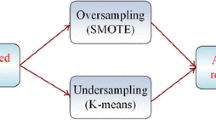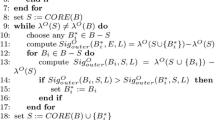Abstract
In rough set based Granular Computing, neighborhood relation has been widely accepted as one of the most popular approaches for realizing information granulation. Such approach is to group samples in terms of their similarities without the consideration of their labels. Therefore, it can be referred to as an unsupervised information granulation strategy. Nevertheless, it is obvious that such unsupervised mechanism may generate imprecise neighborhoods by comparing the actual labels of samples. It follows that it is not good enough for classification-oriented attribute reduction to select qualified attributes. To fill such a gap, a novel supervised information granulation strategy is proposed. Different from the unsupervised information granulation, samples are grouped by using not only the similarities over conditional attributes but also the labels. For such a purpose, our mechanism mainly contains two aspects: (1) intra-class radius, which aims to add samples with the same label into neighborhood; (2) extra-class radius, which aims to delete samples with different labels from the neighborhood. The experimental results over 12 UCI data sets demonstrate that, compared with previous researches, the reducts derived by our supervised information granulation may contribute to superior classification performances. This study suggests new trends and applications of considering information granulation from the viewpoint of supervised learning.




Similar content being viewed by others
References
Chen DG, Li WL, Zhang X, Kwong S (2014) Evidence-theory-based numerical algorithms of attribute reduction with neighborhood-covering rough sets. Int J Approx Reason 55:908–923
Chen DG, Yang YY (2014) Attribute reduction for heterogeneous data based on the combination of classical and fuzzy rough set models. IEEE Trans Fuzzy Syst 22:1325–1334
Chen DG, Yang YY, Dong Z (2016) An incremental algorithm for attribute reduction with variable precision rough sets. Appl Soft Comput 45:129–149
Dai JH, Hu H, Wu WZ, Qian YH, Huang DB (2018) Maximal-discernibility-pair-based approach to attribute reduction in fuzzy rough sets. IEEE Trans Fuzzy Syst 26:2174–2187
Dai JH, Hu QH, Hu H, Huang DB (2018) Neighbor inconsistent pair selection for attribute reduction by rough set approach. IEEE Trans Fuzzy Syst 26:937–950
Dai JH, Hu QH, Zhang JH, Hu H, Zheng NG (2017) Attribute selection for partially labeled categorical data by rough set approach. IEEE Trans Cybern 47:2460–2471
Dubois D, Prade H (1990) Rough fuzzy sets and fuzzy rough sets. Int J Gener Syst 17:191–209
Fujita H, Gaeta A, Loia V, Orciuoli F (2019) Improving awareness in early stages of security analysis: a zone partition method based on GrC. Appl Intell 49:1063–1077
Hu QH, Liu JF, Yu DR (2008) Mixed feature selection based on granulation and approximation. Knowl Based Syst 21:294–304
Hu QH, Yu DR, Liu JF, Wu CX (2008) Neighborhood rough set based heterogeneous feature subset selection. Inf Sci 178:3577–3594
Hu QH, Yu DR, Pedrycz W, Chen DG (2011) Kernelized fuzzy rough sets and their applications. IEEE Trans Knowl Data Eng 23:1649–1667
Hu QH, Yu DR, Xie ZX (2008) Neighborhood classifiers. Expert Syst Appl 34:866–876
Hu QH, Zhang L, Chen DG, Pedrycz W, Yu DR (2010) Gaussian kernel based fuzzy rough sets: model, uncertainty measures and applications. Int J Approx Reason 51:453–471
Jiang ZH, Yang XB, Yu HL, Liu D, Wang PX, Qian YH (2019) Accelerator for multi-granularity attribute reduction. Knowl Based Syst 177:145–158
Ju HR, Li HX, Yang XB, Zhou XZ, Huang B (2017) Cost-sensitive rough set: a multi-granulation approach. Knowl Based Syst 123:137–153
Ju HR, Yang XB, Yu HL, Li TJ, Yu DJ, Yang JY (2016) Cost-sensitive rough set approach. Inf Sci 355–356:282–298
Li JH, Huang CC, Qi JJ, Qian YH, Liu WQ (2017) Three-way cognitive concept learning via multi-granularity. Inf Sci 378:244–263
Li JH, Mei CL, Xu WH, Qian YH (2015) Concept learning via granular computing: a cognitive viewpoint. Inf Sci 298:447–467
Li JH, Ren Y, Mei CL, Qian YH, Yang XB (2016) A comparative study of multigranulation rough sets and concept lattices via rule acquisition. Knowl Based Syst 91:152–164
Li JZ, Yang XB, Song XN, Li JH, Wang PX, Yu DJ (2019) Neighborhood attribute reduction: a multi-criterion approach. Int J Mach Learn Cybern 10:731–742
Li KW, Shao MW, Wu WZ (2017) A data reduction method in formal fuzzy contexts. Int J Mach Learn Cybern 8:1145–1155
Liu D, Li TR, Liang DC (2014) Incorporating logistic regression to decision-theoretic rough sets for classifications. Int J Approx Reason 55:197–210
Liu D, Li TR, Ruan D (2011) Probabilistic model criteria with decision-theoretic rough sets. Inf Sci 181:3709–3722
Liu JH, Lin YJ, Lin ML, Wu SX, Zhang J (2017) Feature selection based on quality of information. Neurocomputing 225:11–22
Liu KY, Yang XB, Fujita H, Liu D, Yang X, Qian YH (2019) An efficient selector for multi-granularity attribute reduction. Inf Sci 505:457–472
Liu KY, Yang XB, Yu HL, Mi JS, Wang PX, Chen XJ (2019) Rough set based semi-supervised feature selection via ensemble selector. Knowl Based Syst 165:282–296
Pawlak Z (1992) Rough sets: theoretical aspects of reasoning about data. Kluwer Academic Publishers, Berlin
Pedrycz W (2015) From fuzzy data analysis and fuzzy regression to granular fuzzy data analysis. Fuzzy Sets Syst 274:12–17
Qian YH, Cheng HH, Wang JT, Liang JY, Pedrycz W, Dang CY (2017) Grouping granular structures in human granulation intelligence. Inf Sci 382–383:150–169
Qian YH, Zhang H, Li FJ, Hu QH, Liang JY (2014) Set-based granular computing: a lattice model. Int J Approx Reason 55:834–852
Śļezak D (2002) Approximate entropy reducts. Fundamenta Informaticae 53:365–390
Shao MW, Leung Y, Wang XZ, Wu WZ (2016) Granular reducts of formal fuzzy contexts. Knowl Based Syst 114:156–166
Shao MW, Li KW (2017) Attribute reduction in generalized one-sided formal contexts. Inf Sci 378:317–327
Song JJ, Tsang ECC, Chen DG, Yang XB (2017) Minimal decision cost reduct in fuzzy decision-theoretic rough set model. Knowl Based Syst 126:104–112
Tsang ECC, Song JJ, Chen DG, Yang XB (2019) Order based hierarchies on hesitant fuzzy approximation space. Int J Mach Learn Cybern 10:1407–1422
Wang CZ, Hu QH, Wang XZ, Chen DG, Qian YH, Dong Z (2018) Feature selection based on neighborhood discrimination index. IEEE Trans Neural Netw Learn Syst 29:2986–2999
Wang CZ, Huang Y, Shao MW, Fan XD (2019) Fuzzy rough set-based attribute reduction using distance measures. Knowl Based Syst 164:205–212
Wang CZ, Shi YP, Fan XD, Shao MW (2019) Attribute reduction based on k-nearest neighborhood rough sets. Int J Approx Reason 106:18–31
Wei W, Liang JY (2019) Information fusion in rough set theory: an overview. Inf Fus 48:107–118
Wei W, Wu XY, Liang JY, Cui JB, Sun YJ (2018) Discernibility matrix based incremental attribute reduction for dynamic data. Knowl Based Syst 140:142–157
Wilconxon F (1945) Individual comparisons by ranking methods. Biometrics 1:80–83
Wu WZ, Leung Y (2011) Theory and applications of granular labelled partitions in multi-scale decision tables. Inf Sci 181:3878–3897
Wu WZ, Qian YH, Li TJ, Gu SM (2017) On rule acquisition in incomplete multi-scale decision tables. Inf Sci 378:282–302
Wu ZB, Mao KZ, Ng GW (2018) Enhanced feature fusion through irrelevant redundancy elimination in intra-class and extra-class discriminative correlation analysis. Neurocomputing 335:105–118
Xu SP, Yang XB, Yu HL, Yu DJ, Yang JY, Tsang ECC (2016) Multi-label learning with label-specific feature reduction. Knowl Based Syst 104:52–61
Xu WH, Guo YT (2016) Generalized multigranulation double-quantitative decision-theoretic rough set. Knowl Based Syst 105:190–205
Xu WH, Li WT (2016) Granular computing approach to two-way learning based on formal concept analysis in fuzzy datasets. IEEE Trans Cybern 46:366–379
Xu WH, Li WT, Luo SQ (2015) Knowledge reductions in generalized approximation space over two universes based on evidence theory. J Intell Fuzzy Syst 28:2471–2480
Xu WH, Yu JH (2017) A novel approach to information fusion in multi-source datasets: a granular computing viewpoint. Inf Sci 378:410–423
Yang X, Li TR, Fujita H, Liu D (2019) A sequential three-way approach to multi-class decision. Int J Approx Reason 104:108–125
Yang X, Li TR, Fujita H, Liu D, Yao YY (2017) A unified model of sequential three-way decisions and multilevel incremental processing. Knowl Based Syst 134:172–188
Yang X, Li TR, Liu D, Chen HM, Luo C (2017) A unified framework of dynamic three-way probabilistic rough sets. Inf Sci 420:126–147
Yang XB, Qi YS, Song XN, Yang JY (2013) Test cost sensitive multigranulation rough set: model and minimal cost selection. Inf Sci 250:184–199
Yang XB, Song XN, Chen ZH, Yang JY (2012) On multigranulation rough sets in incomplete information system. Int J Mach Learn Cybern 3:223–232
Yang XB, Yao YY (2018) Ensemble selector for attribute reduction. Appl Soft Comput 70:1–11
Yao YY (2018) Three-way decision and granular computing. Int J Approx Reason 103:107–123
Yao YY, Zhao Y, Wang J (2008) On reduct construction algorithms. Trans Comput Sci II(5150):100–117
Zadeh LA (1997) Toward a theory of fuzzy information granulation and its centrality in human reasoning and fuzzy logic. Fuzzy Sets Syst 90:111–127
Zhang X, Mei CL, Chen DG, Li JH (2016) Feature selection in mixed data: a method using a novel fuzzy rough set-based information entropy. Pattern Recognit 56:1–15
Zhang XY, Wei L, Xu WH (2017) Attributes reduction and rules acquisition in an lattice-valued information system with fuzzy decision. Int J Mach Learn Cybern 8:135–147
Zhang Z, Xu Y, Shao L, Yang J (2018) Discriminative block-diagonal representation learning for image recognition. IEEE Trans Neural Netw Learn Syst 29:3111–3125
Zhu PF, Hu QH (2013) Adaptive neighborhood granularity selection and combination based on margin distribution optimization. Inf Sci 249:1–12
Zhu PF, Hu QH, Zuo WM, Yang M (2014) Multi-granularity distance metric learning via neighborhood granule margin maximization. Inf Sci 282:321–331
Acknowledgements
The authors would like to thank the editors and anonymous reviewers for their constructive comments. In addition, the authors would like to thank Eric Appiah Mantey and Selase Tawiah Kwawu for helping us improve the language quality of this article. This work is supported by the Natural Science Foundation of China (Nos. 61572242 and 61906078) and the Postgraduate Research & Practice Innovation Program of Jiangsu Province (No. KYCX19_1715).
Author information
Authors and Affiliations
Corresponding author
Additional information
Publisher's Note
Springer Nature remains neutral with regard to jurisdictional claims in published maps and institutional affiliations.
Rights and permissions
About this article
Cite this article
Liu, K., Yang, X., Yu, H. et al. Supervised information granulation strategy for attribute reduction. Int. J. Mach. Learn. & Cyber. 11, 2149–2163 (2020). https://doi.org/10.1007/s13042-020-01107-5
Received:
Accepted:
Published:
Issue Date:
DOI: https://doi.org/10.1007/s13042-020-01107-5




